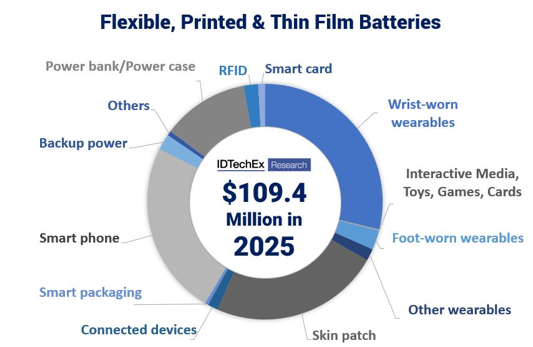
What is the future for thin-film, flexible & printed batteries
By IDTechEx, Cambridge, UK
Electronics Power Supply / Management batteries battery film Flexible printed thinHigher costs/prices, unestablished supply chain, limited market demand and developing technologies
The battery industry has experienced enormous innovation and investment with the demand mainly from electric vehicles and energy storage systems. The 1,500GWh market demand in 2030 indicates huge potential for batteries.
While another area of battery innovation initially came from technology push, with the focus on the following aspects:
- Thickness: ultra-thin batteries with significant thickness and weight reduction,
- Mechanical properties: flexible, rollable and bendable batteries with different form factors,
- Manufacturing method: different from traditional coating and winding/stacking techniques, the batteries can be mainly made by the printing method.
This less competitive, less mature industry has been struggling for a long time, with giants such as Apple, LG, Samsung plunged into water but later became very quiet due to various reasons. Early players have experienced the frustration by holding a hammer to look for nails.
Different from electric vehicle application, thin-film, flexible and printed batteries are mainly targeting consumer devices and they are in the relatively early stage of adoption. With higher costs/prices, unestablished supply chain, limited market demand, and developing technologies, thin-film, flexible and printed batteries need to be watched from different angles compared with those used for electric vehicles.

Source: IDTechEx Research
Over 10 years of development, this industry is gradually experiencing a transition from technology push to market pull. IDTechEx has been tracking the progress of this area since 2014 and according to the report “Flexible, Printed and Thin Film Batteries 2020-2030”, the market for such batteries will grow to $500 million in 2030.
On one hand, the technology approaches for this area have been more mature. This means the available technologies in the market can be classified into several categories, delivering predictable performance. This also means that the individual technology category has its specification range and suitable targeting markets with its capabilities and limitations.

Source: IDTechEx Research
On the other hand, the development of thin-film, flexible and printed batteries’ targeting markets requires the last piece—power sources. Although the applications for smart cards, RFID, interactive media, toys, games, cards and smart packaging have existed for ages, the growth in health, fitness, cosmetic and medical sectors, wearables, smart phones and professional applications are experiencing further innovations and thus looking for new kinds of power solutions.
With a higher level of adoption and mass production, specialization is easy to be realized in the electric vehicle supply chain. Battery vendors mainly focus on manufacturing as the suppliers for electric vehicles. However, this level of segmentation is still difficult for thin-film, flexible and printed batteries. Therefore, the successful players in this sector are highly involved with final product development as well. There are also more business models available. The key for thin, flexible, and printed batteries to succeed is to target correct applications, based on the capabilities and limitations of the battery. Currently, moving down along the supply chain is also important.
